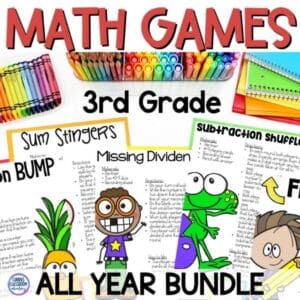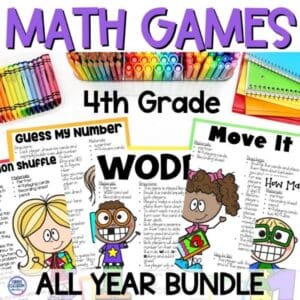Looking for ways to teach math concepts using simple dollar store materials? Look no further than your trusty deck of playing cards! Today, I’ve got a lineup of creative math games with playing cards that will turn your next math session into game time.
Game 1: Guess My Number

Materials:
Deck of cards and this free recording sheet
How To Play:
- Each player draws six cards and secretly builds a six-digit number with the numbers facing down.
- Players take turns asking one YES or NO question at a time to figure out their partner’s number.
- When asking for clues you may NOT ask for a specific number (example: Is the number in your tens place a 3?)
- You may only ask less direct questions such as: Is the digit in your tens place even? Is the digit in your ones place greater than 5? Is the digit in your hundreds place greater than the digit in your thousands place?
- Eliminate possible numbers and record those you know until you have all six digits figured out.
Why It Works:
- Mystery: Solving a mystery keep students engaged
- Critical Thinking: Students have to get creative in asking questions to get to the answer in as few turns as possible
Game 2: I Spy Equations
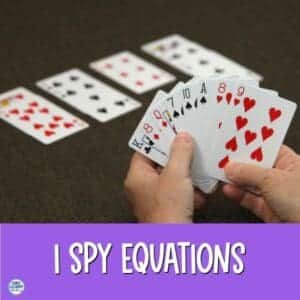
Materials:
Deck of cards (Ace through King), where Ace is worth 1 or 11.
How to Play:
- Setup: Deal out the entire deck of cards in a 13 x 4 grid.
- Gameplay:
- Player 1 starts by identifying a pair of cards adjacent to each other (either vertically or horizontally) that add up to a specified number. For example, “I spy two cards with a product of 24.”
- Player 2 searches for the pair of cards that fulfill the condition and removes them from the grid.
- Alternatively, you can play with addition or subtraction: “I spy two cards with a sum of 15 or a difference of 5.”
- Continuation: After removing the identified pair, reshuffle the remaining cards to reform the grid and continue playing.
Why It Works:
- Engaging Format: By turning math into a game of spotting and solving, students stay focused and actively involved.
- Flexibility: Adapt the game to various skill levels by adjusting the target number or introducing extra challenges.
- Critical Thinking: Encourages strategic thinking and quick mental math calculations.
Variations:
- Increase difficulty by using equations that involve 3 cards.
- Time-based challenge: Set a timer and see how many pairs players can find within a given timeframe.
Game 3: Shuffle
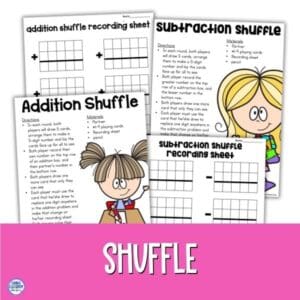
Materials:
Deck of Cards
How to Play:
- In each round, both players will draw 5 cards, arrange them to make a 5-digit number and lay the cards face up for all to see.
- Both player record their own number on the top row of an addition box, and their partner’s number in the bottom row.
- Both players draw one more card that only they can see.
- Each player must use the card that he/she drew to replace one digit anywhere in the addition problem and make that change on his/her recording sheet.
- Both players solve their addition equations and compare answers.
- The player with the largest sum wins that round.
Why it Works:
- Strategy: Students have to use critical thinking and strategize when using their replacement card to give themselves the best chance of winning each round.
Variations:
- Have students build numbers to subtract instead of add. For this variation, remind students to put the larger number on top.
Game 4: Move It
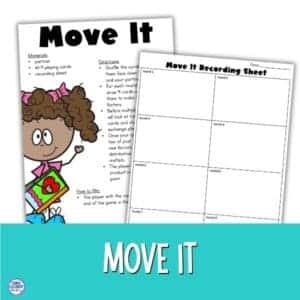
Materials:
a deck of cards
How to Play:
- Shuffle the cards and place them face down between you and your partner.
- For each round, both players draw 4 cards and arrange them to make two 2-digit factors.
- Before multiplying, each player will look at his opponent’s cards and choose 2 cards to exchange places.
- Once your opponent has moved two of your cards to create new factors, multiply to find the product.
- The player with the highest product in each round earns a point.
Why It Works:
- Quick Set Up: Since it requires very little time or supplies to play each round, this makes a great transition time activity when you have just a few minutes to fill
- Equalizer: Letting students rearrange cards makes it less likely for one player be an obvious winner before the computations are done.
Variations:
- Play with addition or subtraction instead.
There you have it—4 fantastic games that turn a deck of cards into a powerful tool for practicing math concepts. Whether you’re focusing on addition, multiplication, or place value these games are sure to make math sessions lively…but we don’t want it to get too lively so here is a free set of math game expectations posters to help you keep the game time chaos to a minimum!
Next time you’re planning a math lesson or need an engaging activity, grab a deck of cards and let the games begin!
For year long supply of math games with playing cards and dice check out one of these game bundles. Available for 3rd grade or 4th grade!
Get 4 Free Resources Every Month!
You read that right! I’ll share an easy-to-use and engaging upper elementary resource straight to your inbox every week along with a fabulous classroom idea or two to make teaching a little less work and a lot more fun!
Here’s the first freebie to get you started!
CLICK HERE TO GRAB YOUR FIRST FREE RESOURCE TODAY!
Check out even more great ideas for your math classroom with one of these articles:
Shamrockin’ Early Finisher Ideas: 7 Saint Patrick’s Day Activities for Upper Elementary


